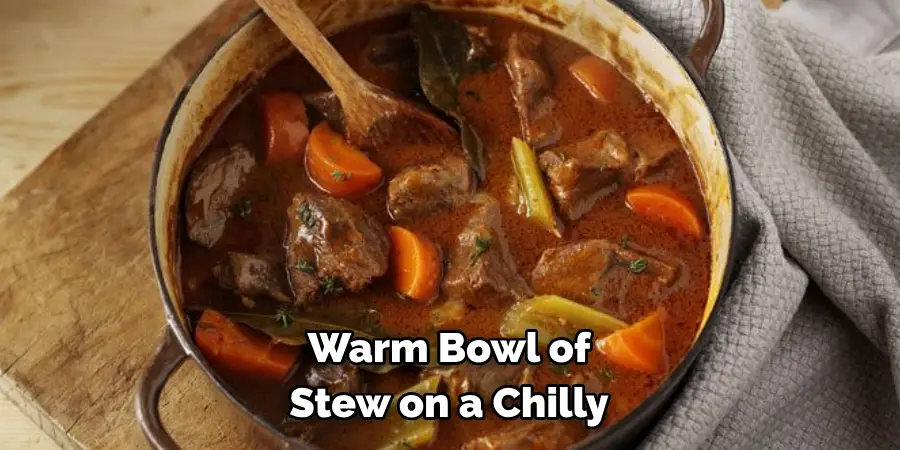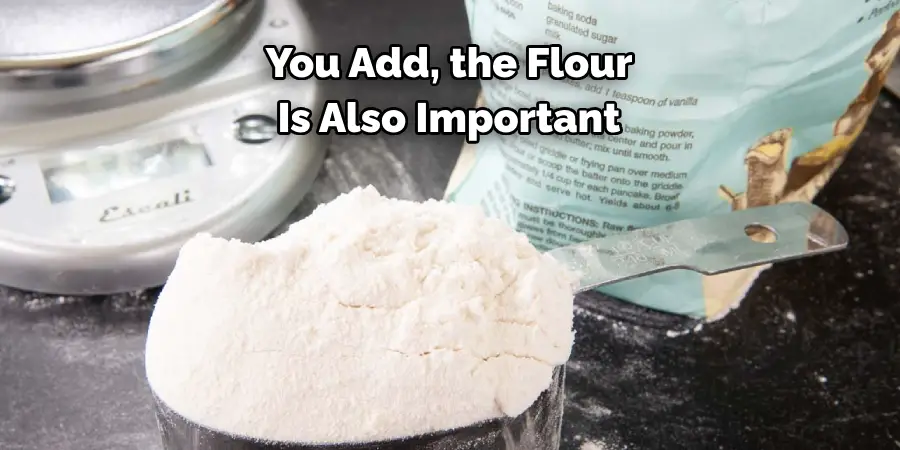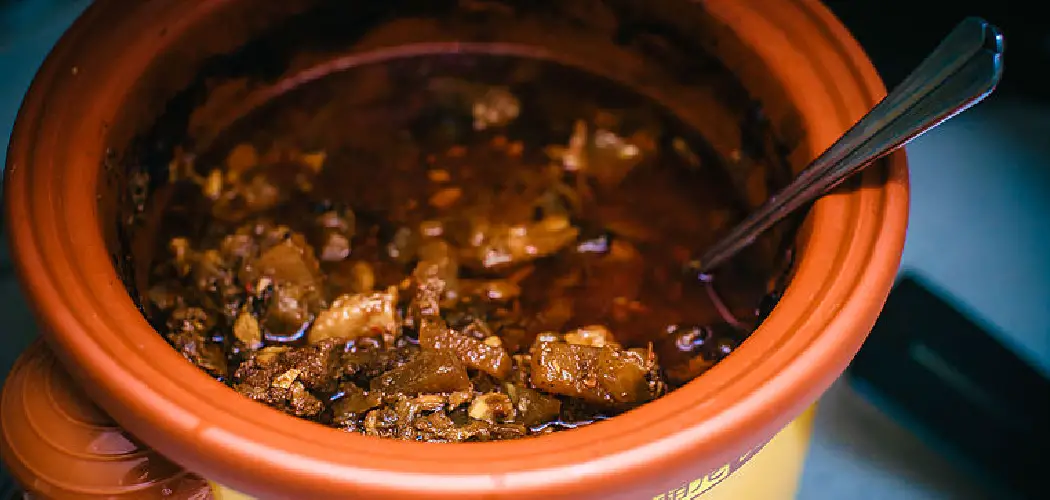Do you love making a stew but find that most recipes just don’t turn out as thick and flavorful as you’d like? Don’t worry. This is an easy fix!
With the help of your slow cooker and some kitchen tricks, anyone can master the art of perfect stew. In this blog post, we’ll cover all the steps necessary to thicken up your homemade stews for a meal that’s sure to tantalize your taste buds.
So if you’re ready to challenge yourself in the kitchen with delicious results guaranteed, then let’s get started to learn more about how to thicken stew in slow cooker.

Can You Thicken Stew in a Slow Cooker?
There’s nothing quite like a hot, hearty bowl of stew on a chilly winter night. But what happens when your stew turns out watery and thin instead of thick and hearty? Don’t despair – you can easily thicken your stew in the slow cooker!
You can try several methods, from adding flour or cornstarch to using a roux or pureeing some of the vegetables. With some experimentation, you can turn your thin, lackluster stew into a rich, satisfying comfort food that your whole family will enjoy. So why not try it and see what works best for you? Your taste buds (and stomach) will thank you!
Why Should You Thicken Stew in Slow Cooker?
Nothing quite like a hearty, warm bowl of stew on a chilly evening to comfort your soul. However, sometimes the broth can be thin and watery, leaving you unsatisfied. That’s where the slow cooker comes in handy. Letting your stew simmer away for hours in the slow cooker allows the ingredients to meld together into a flavorful and rich dish.
But to take your stew to the next level, thickening it up a bit is important. Not only does a thicker stew allow the flavors to concentrate more, but it also creates a more satisfying texture that’s perfect for dipping crusty bread. So next time you make a stew in your slow cooker, consider thickening it up for the ultimate comfort food experience.
Understanding Stew Thickness
1. Definition of Stew Thickness
Stew thickness refers to the viscosity or consistency of the stew’s liquid component. A thick, hearty stew typically clings to the ingredients and coats your spoon, providing a rich and satisfying experience. On the other hand, a thin stew has a more soup-like consistency, with the liquid running freely and not adhering as much to the components of the stew.
2. Common Challenges in Achieving the Desired Thickness
One common challenge in achieving the desired thickness is the use of too much liquid, resulting in a stew that’s more similar to soup. Another challenge is patience; stews often need to simmer for an extended period for the flavors to meld and the stew to thicken naturally. On the other hand, attempting to rush the process by adding thickening agents prematurely may result in an unappetizing, gloppy texture.
3. Importance of Balancing Flavors and Consistency
Balancing flavors and consistency is crucial in crafting a delicious stew. While thickness contributes to the mouthfeel and the overall eating experience, the balance of flavors is equally important. A well-thickened stew with bland or overpowering flavors is as unappealing as a flavorful but watery stew. Therefore, it’s essential to manage both aspects, using the right mix of ingredients for depth of flavor and the appropriate thickening technique for the desired consistency.
What Ingredients You’ll Need for Thickening Stew in Slow Cooker
To thicken your stew, you’ll need some basic ingredients that are commonly found in most household kitchens. Here’s a list of what you’ll need:
- Flour or cornstarch
- Water or broth
- Roux (a mixture of flour and fat)
- Pureed vegetables from the stew

How to Thicken Stew in Slow Cooker – Tips and Tricks
1. Reducing the Amount of Liquid in Your Recipe
Start by reducing the amount of liquid in your recipe. This might sound counterintuitive, but thinner stews often have too much liquid. Leaving the crockpot lid off for the last hour of cooking evaporates some liquid, making for a thicker result. Alternatively, you can transfer your stew to a pot on the stove and simmer over low heat until the excess liquid has reduced.
2. Add a Roux
Another common way to thicken your stew is to add a roux. A roux is a mixture of flour and fat cooked on the stovetop until the flour is browned slightly. Using a small saucepan, melt some butter over medium heat and add an equal amount of flour. Whisk constantly until the roux has browned (3-4 minutes), then add it to your slow cooker.
3. Add Cornstarch and Potato Starch
If you’re aiming for a gluten-free option, cornstarch and potato starch are great substitutes for flour. In a small bowl, dissolve a tablespoon of flour in cold water, then whisk the mixture into your stew. Wait until the last hour of cooking, as cornstarch can break down over time and give your stew a slimy texture.

4. Add Starchy Vegetable
Want to give your stew a velvety texture and an extra punch of flavor? Try adding a starchy vegetable like potatoes or parsnips. As these vegetables cook, they release natural starches that thicken the sauce and add a rich, savory taste. Add your potatoes or parsnips halfway through the cooking time or until tender and easily pierced with a fork.
5. Add Quick-Cooking Oats
Whether you are trying to add body to your stew or need something more substantial, quick-cooking oats are a great option. Oats are naturally gluten-free and can be stirred into the stew in the last hour of cooking. If you want even more texture, add pulsed steel-cut oats to hold their shape and provide a heartier bite.
6. Add Tomato Paste
Tomato paste is an excellent thickener for slow cooker stews. Not only does it give the stew a deeper flavor, but it also helps to thicken the sauce significantly. Simply add a tablespoon of tomato paste to your stew in the last hour of cooking and stir until fully incorporated.
7. Use a Slow Cooker Liner
If all else fails, you can always use a slow cooker liner to thicken your stew. A slow cooker liner is a plastic bag that fits inside the crockpot, trapping heat and moisture while preventing food from sticking to the sides and bottom of the pot.
That’s it! You’ve now learned seven ways to thicken stew in a slow cooker. Whether you’re looking for a gluten-free option or need something to make your stew more substantial, these methods will have you whipping up delicious dishes quickly. Bon Appetit!
How to Choose the Right Thickener
When it comes to thickening your slow cooker stew, you’ll need to consider a few factors. The choice of thickener can affect not just the consistency of your stew but also its flavor, color, and suitability for various dietary preferences.
Consideration of Flavor and Color
Different thickeners can subtly change the taste and color of your stew. For instance, flour can provide a slightly nutty, roasted flavor, while cornstarch is relatively flavorless but can give the stew a glossy appearance. Be careful with tomato paste or roux, as they can darken the stew and impart a stronger, specific flavor.
Dietary Restrictions and Preferences
Remember to consider any dietary restrictions or preferences when choosing your thickener. Cornstarch and arrowroot are good gluten-free options. If you’re cooking for someone who follows a Paleo or Whole30 diet, tapioca flour or arrowroot powder might be more suitable. For a low-carb or keto-friendly approach, try using xanthan gum or a touch of cream cheese to create a silky, thick texture.
Tips on Experimenting with Different Thickeners
Experimentation is key in finding what works best for your stew. Start with a small amount of thickener, gradually adding more if needed. Remember to mix flour or cornstarch with cold water before adding to the stew to avoid lumps. If using a roux, cook it until it reaches the desired color before adding it to the stew, being careful not to burn it. Always taste your stew after adding the thickener to make sure it enhances, not overpowers, the existing flavors.
5 Considerations Things When You Need to Thicken Stew in a Slow Cooker
1. The Type of Flour You Use

The type of flour you use will affect how well the stew thickens. All-purpose flour is a good option for thickening, as it will thicken without changing the stew’s flavor too much. However, you can also use other types of flour, such as whole wheat flour or gluten-free flour.
2. How Much Flour You Use
How much flour you use is also important. If you use too much flour, the stew will be too thick and may have a gummy texture. If you use too little flour, the stew will not be thickened enough.
3. When You Add the Flour
When you add, the flour is also important. If you add the flour at the beginning of cooking, it will have time to incorporate into the stew and thicken it evenly and fully. However, if you add the flour towards the end of cooking, it may not have enough time to be fully incorporated, resulting in lumps.

4. How Long You Cook the Stew
How long you cook the stew is also important. If you cook too long, the ingredients may break down, making the stew thinner. If you do not cook the stew long enough, the flour will not have enough time to incorporate and thicken the stew fully.
5. The Other Ingredients in Your Stew
The other ingredients in your stew can also affect how well it thickens. For example, if your stew contains a lot of liquid, such as broth or water, it will take longer to thicken than if it contains less liquid. Additionally, if your stew contains thicken ingredients, such as potatoes or rice, it may not need as much flour to achieve the desired consistency.
These are all important considerations when thickening stew in a slow cooker. By taking into account the type of flour, how much flour, when to add it, how long to cook it, and what other ingredients are included in your stew, you can achieve the desired consistency for your dish. With a little practice and experimentation, you will have perfect, thickened stews in no time!
5 Benefits of Thicken Stew in Slow Cooker
1. It’s Easy
One of the primary benefits of using a slow cooker to thicken stew is that it’s easy. All you need to do is add the ingredients to the slow cooker and let it work. There’s no need to watch the stew carefully or stir it frequently, as you would if you were thickening it on the stovetop.
2. It’s Convenient
Another benefit of using a slow cooker to thicken stew is convenience. You can set the slow cooker to cook while you’re at work or running errands and then come home to a thick, delicious stew ready to eat. This is especially helpful on busy weeknights when you don’t have time to spend hours in the kitchen cooking dinner.
3. It Keeps the Stew Hot
If you’re thickening stew on the stovetop, there’s a risk that it will cool down and become less flavorful. However, if you’re using a slow cooker, the stew will stay hot until you’re ready to serve it. This is ideal if you have guests over for dinner or want to keep the stew hot for leftovers later in the week.
4. It Prevents Scorching
When thickening stew on the stovetop, there’s also a risk of scorching if the heat is too high or the mixture isn’t stirred frequently enough. However, this isn’t a concern with a slow cooker since the heat is evenly distributed, and there’s no need to stir. As a result, your stew will be less likely to scorch and more flavorful.
5. It Makes Cleanup Easy
Finally, another benefit of using a slow cooker to thicken stew is that it makes cleanup easy. Since you won’t need to use multiple pots and pans, you will have fewer dishes to wash at the end of the night. Additionally, most slow cookers have removable pot liners that can be placed in the dishwasher for easier cleanup.
Some Common Mistakes People Make When Trying to Thicken Stew in Slow Cooker
At the end of a long day, there’s nothing quite like a warm, hearty stew to comfort the soul. However, as tempting as it may be to rush through the cooking process, adding too much thickening agent might not be the best idea. Many people make the mistake of overloading their slow cooker with flour or cornstarch, hoping to achieve a thicker consistency.

But overusing these ingredients can lead to an unpleasant and gluey texture. Another mistake is adding dairy products too early, as they can curdle and separate when exposed to high temperatures for too long. Learning the dos and don’ts of thickening stew can make all the difference in achieving a truly delicious and satisfying meal.
What Ingredients Should be Added at the End of Cooking to Achieve Maximum Thickness
If you want to achieve maximum thickness for your stew, there are certain ingredients that should be added at the very end of cooking. Dairy products such as cream and cheese should be added last, as they can curdle if cooked too long. Additionally, cornstarch or other thickeners should also be stirred in towards the end of cooking in order to ensure that they don’t break down. Lastly, butter can also be added towards the end of cooking to achieve a rich and creamy texture. By adding these ingredients at the end of cooking, you can ensure that your stew is thick and delicious!
What to Look for When Choosing a Thickening Agent
When choosing a thickening agent, there are several factors to consider. First, you should look at the ingredient list of the product and make sure that it does not contain any artificial flavors or preservatives. Additionally, you should choose an organic option if possible, as this will ensure that it is free of toxins and chemicals. Finally, you should also consider the type of stew you are making and choose a thickening agent that will best suit your needs. With these tips in mind, you can easily find the perfect thickener for your stew!
Tips to Make Your Stew Even Thicker
If you’re looking to make your stew even thicker, there are a few simple tricks you can use. One way is to add more potatoes or vegetables, as these ingredients will naturally thicken the stew.
Additionally, adding some uncooked grains, such as barley or rice, at the start of cooking can help absorb some of the liquid and create a thicker consistency.
Finally, you can also try adding pureed beans or lentils towards the end of cooking, as these ingredients can also add thickness and body to the stew. With these tips in mind, you’ll be able to achieve the perfect consistency for your dish!
Flavor Enhancement Tips
Balancing Flavors After Thickening
After thickening your stew, it’s important to ensure the flavors remain balanced. This process involves tasting the stew and adjusting the seasonings as necessary. For instance, if your stew tastes too salty, you can add a splash of vinegar or lemon juice to balance it out. Conversely, if it’s too acidic, a pinch of sugar can restore balance. Adjusting seasonings after thickening ensures that your stew remains flavorful and satisfying.
Utilizing Herbs and Spices for Added Depth
Herbs and spices can significantly enhance the depth of flavor in your stew. Bay leaves, thyme, and rosemary are great options for most stews, providing a robust and aromatic backdrop. For a hint of heat, consider adding crushed red pepper flakes or a touch of cayenne. Remember to add these ingredients in moderation and taste as you go, as it’s easier to add more flavor than to remove it once added.
Incorporating Umami-Rich Ingredients
Umami-rich ingredients, often referred to as the fifth taste, can add a deep, savory dimension to your stew. Ingredients such as soy sauce, Worcestershire sauce, tomato paste, or mushrooms are excellent sources of umami. Adding a small amount of these ingredients can greatly enhance the overall flavor of your stew, making it richer and more complex.
Troubleshooting Thickening Issues
1. Addressing Overly Thickened Stew
If your stew has become overly thick, don’t fret. There are a few simple solutions to address this issue. One option is to add more broth or water to dilute the stew until you reach your desired consistency. Be sure to add the liquid slowly and stir well after each addition to avoid making the stew too thin. If the flavor dilutes too much after adding liquid, adjust the seasonings to maintain the stew’s robust taste.
2. Solutions for Thin or Watery Stew
On the other hand, if your stew is too thin or watery, there are a few methods you can employ. First, try letting the stew simmer uncovered for a while, allowing some of the liquid to evaporate. Another option is to add a thickening agent such as cornstarch mixed with a bit of cold water or a roux made from equal parts butter and flour. Add your chosen thickener slowly while stirring, allowing the stew to cook a little longer until the desired thickness is achieved.
3. Adjusting Consistency During the Cooking Process
Adjusting the consistency of your stew during the cooking process can be a bit tricky, but it’s definitely manageable. If your stew appears too thin midway through cooking, try removing the lid to let some of the liquid evaporate. Alternatively, consider adding more of your thickening ingredients, whether that’s chopped vegetables, uncooked grains, or a thickening agent like cornstarch or flour. If it’s too thick, consider adding more liquid. Remember to taste and adjust seasonings as you make these changes to ensure a flavorful outcome.
Creative Ways to Serve Leftover Stew from the Slow Cooker
1. Stuffed Bell Peppers
For a fun and unique twist on traditional stuffed peppers, try using leftover stew as the filling instead of ground meat. Simply cut the tops off of bell peppers, remove the seeds, and stuff with your leftover stew. Bake in the oven until the peppers are soft and heated through for an easy and satisfying meal.
2. Shepherd’s Pie
Transform your stew into a hearty shepherd’s pie by layering it with mashed potatoes and baking until the top is golden brown. You can also add other ingredients, such as peas, carrots, or corn, to the stew for added texture and flavor.
3. Stew Quesadillas
For a quick and tasty meal, use leftover stew as a filling for quesadillas. Heat up the stew, spoon it onto a tortilla, add your desired toppings like cheese and peppers, and fold over to create a half-moon shape. Cook in a pan until crispy on both sides and serve with sour cream or salsa.
4. Stew Pizzas
Another fun way to repurpose leftover stew is to turn it into a pizza topping. Spread the stew over a pre-made pizza crust and add your favorite toppings like cheese, onions, or mushrooms. Bake until the crust is golden brown and the cheese is melted for a tasty and unique meal.
5. Stew-Stuffed Baked Potatoes
For a simple yet satisfying meal, use leftover stew as a filling for baked potatoes. Bake your desired number of potatoes until soft, slice them open, and spoon the stew on top. You can also add toppings like cheese, sour cream, or chives for added flavor. This is a great option for using up small amounts of leftover stew.
With these tips and tricks, you can easily thicken your stew to achieve the perfect consistency and enhance its flavor. And if you happen to have leftovers, don’t let them go to waste! Get creative and repurpose your stew into new and delicious meals that will leave your family wanting more.
Conclusion
A perfect bowl of stew should be rich, thick, and flavourful, and with these tips and tricks, you’ll be on your way to slow cooker success in no time. Whether you prefer a classic beef and vegetable recipe or something more adventurous like gumbo or curry, you can achieve the perfect texture and taste.
So next time you’re craving a comforting bowl of stew, remember these tips and impress your family or guests with a perfect thickened stew every time. Thanks for reading our post about how to thicken stew in slow cooker.
You Can Check it Out to Cook Boudin Without It Exploding

